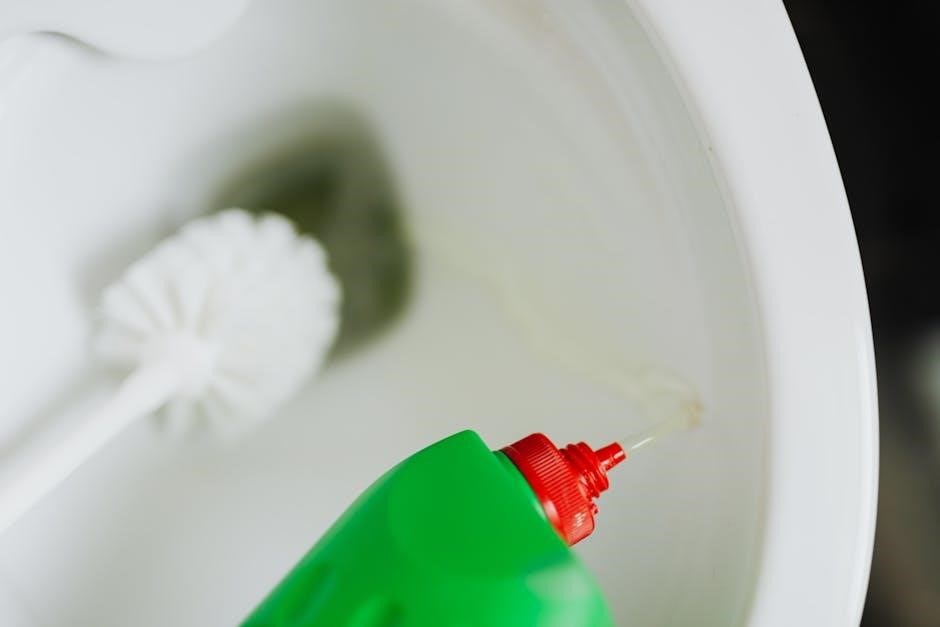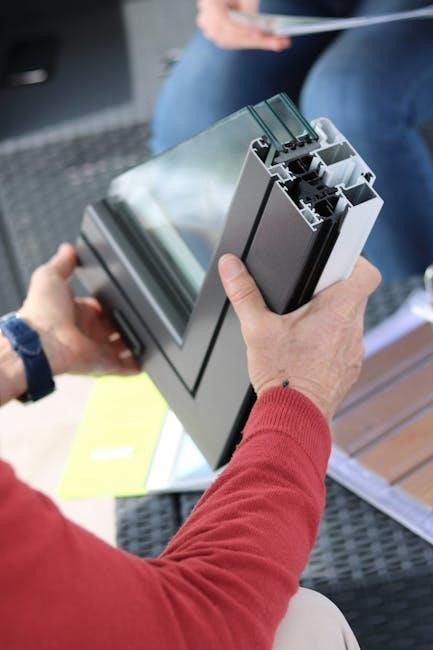
how to remove a manual window crank
Removing a manual window crank is a straightforward process that requires basic tools and careful steps to avoid damage. This guide provides a clear, step-by-step approach to safely detach and replace the crank, ensuring smooth window operation and maintaining your vehicle’s interior integrity.
1.1 Importance of Removing the Window Crank
Removing the window crank is essential for maintaining proper window functionality and aesthetics. It allows for easy replacement of damaged or worn-out parts, ensuring smooth operation. Additionally, removing the crank prevents potential damage during repairs or upgrades. This step is crucial for accessing internal mechanisms, making it a foundational part of any window-related maintenance or modification. Proper removal also ensures safety and avoids unintended breakage during handling.
1.2 Common Reasons for Removal
Common reasons for removing a manual window crank include replacing a broken or worn-out handle, upgrading to a newer design, or accessing internal mechanisms for repairs. Damage from accidents or heavy use often necessitates removal. Additionally, removing the crank can prevent further damage during door panel repairs or when upgrading window regulators. It’s also a necessary step for customizations, ensuring a clean and functional interior. Addressing these issues promptly helps maintain your vehicle’s efficiency and appearance.
Tools and Materials Needed
The essential tools include a screwdriver, pliers, and a punch tool to remove clips. Additional materials like gloves and a soft cloth protect surfaces during removal.
2.1 Essential Tools for the Job
The primary tools needed are a screwdriver for dismantling the door panel and accessing the crank mechanism. Pliers or a wrench may be required to grip and twist the crank handle. A flathead screwdriver can help pry components gently. Additionally, a punch tool or clip remover is useful for releasing clips holding the crank in place. These tools ensure a safe and efficient removal process without damaging surrounding parts.
2.2 Additional Materials Required
Besides the essential tools, you may need protective gloves and eye protection to prevent injury. A punch tool or clip remover can assist with stubborn clips. A soft-faced hammer may be useful for gently tapping components. Lubricants, such as silicone spray, can help loosen stuck parts. Finally, having replacement clips or crank handles on hand ensures you’re prepared for any damage encountered during removal.
Preparing the Door Panel
Preparing the door panel involves removing screws, clips, and trim to access the window crank mechanism. Handle with care to avoid damage to wiring or panels.
3.1 Removing the Door Panel
To remove the door panel, start by taking out the visible screws and clips around the edges. Gently pry the panel away from the door frame using a flathead screwdriver or specialized tool. Be cautious of wiring and electrical components connected to the panel. Once loosened, carefully lift the panel off and set it aside to access the window crank mechanism. This step ensures safe and easy access for further disassembly.
3.2 Accessing the Window Crank Mechanism
With the door panel removed, locate the window crank mechanism. Remove any covers or screws to expose it. Gently disconnect electrical connectors if present. This access allows you to remove or repair the crank. Handle components carefully to avoid damage.

Detaching the Window Crank Handle
Inspect the handle to identify the attachment method. If held by a clip, use a flathead screwdriver to pry it off. For screw-type handles, unscrew and twist gently to remove.
4.1 Identifying the Crank Handle Attachment
Examine the base of the window crank handle to determine its attachment type. Most handles are secured with a small metal clip, screw, or retaining ring. For clip-style attachments, look for a slight gap between the handle and the door panel. Screw-type handles will have visible screws holding them in place. Use a flathead screwdriver to gently pry or unscrew the handle, ensuring the underlying mechanism remains secure during removal.
4.2 Methods to Remove the Handle
The handle can be removed by gently prying it off with a flathead screwdriver or by unscrewing it, depending on the attachment type. For clip-style handles, carefully insert the screwdriver into the gap and twist slightly to release the clip. For screw-type handles, remove the visible screws and slide the handle off. Avoid using excessive force to prevent damage. If stuck, apply penetrating oil or heat. Always use caution to ensure the underlying mechanism remains intact.

Handling the Window Regulator
Handling the window regulator involves disconnecting its mechanism from the crank. Carefully lift the window to access the crank, ensuring the regulator is secure during removal.
5.1 Understanding the Regulator Mechanism
The window regulator mechanism is essential for moving the window up and down. It consists of a gear system connected to the crank handle, which operates the window’s vertical movement. Understanding how the gears and levers interact helps in safely disconnecting the regulator without causing damage to the window or door assembly. Proper alignment and lubrication of the mechanism ensure smooth operation and prevent wear over time.
5.2 Safely Disconnecting the Regulator
To disconnect the regulator, first, stabilize the window to prevent it from falling. Use a screwdriver to remove the screws securing the regulator to the door frame. Gently pull the regulator away from the crank mechanism, ensuring no cables or gears are strained. Once disconnected, the crank can be removed without affecting the window’s position. Proper disconnection prevents damage to the mechanism and ensures smooth reassembly later.

Reinstalling or Replacing the Crank
Reinstalling or replacing the crank involves aligning it properly with the regulator mechanism. Secure it with screws or clips, ensuring a tight fit for smooth operation.
6.1 Installing a New Crank Handle
Installing a new crank handle starts by aligning it with the regulator mechanism. Secure it using the appropriate screws or clips, ensuring a snug fit to prevent movement. Gently test the handle to confirm smooth rotation and proper engagement with the window gear. Ensure all connections are tight and the handle operates effortlessly. This step restores functionality and enhances the overall appearance of the door panel.
6.2 Reassembling the Door Panel
Reassembling the door panel involves reattaching all previously removed components, such as the armrest, door handle, and trim. Secure these parts using the original screws or clips. Ensure proper alignment to avoid damage or misfit. Reconnect any electrical connectors for features like power windows or locks. Gently tap the panel back into place using a soft mallet to avoid scratching the door. Finally, test the window operation to confirm everything functions smoothly and check for any gaps or unevenness in the panel fit.
Tips for Stuck or Difficult Cranks
When dealing with a stuck window crank, apply gentle prying with a flathead screwdriver and consider lubrication to loosen the mechanism. Exercise patience to avoid breaking the crank or surrounding components.
7.1 Dealing with Stubborn Crank Handles
For stubborn crank handles, start by inspecting for hidden clips or screws. Apply penetrating oil to loosen corrosion. Gently pry the handle with a flathead screwdriver, working carefully to avoid breaking the mechanism. If the handle doesn’t budge, heat from a hairdryer can expand the metal slightly, making removal easier. Avoid excessive force, as this could damage the window regulator or surrounding door components. Patience and careful manipulation are key to safe removal.
7.2 Avoiding Damage During Removal
To avoid damaging the door panel or crank mechanism, use care when removing the handle. Avoid applying excessive force, which could scratch or break components. Instead, gently pry the handle while ensuring the door panel is secure. Protect surrounding areas with a cloth to prevent accidental marks. Lubricate stuck parts to reduce friction and minimize the risk of damage. Patience and controlled movements are essential to safely remove the crank without causing harm to the vehicle’s interior or window system.
Removing a manual window crank is a manageable task with proper tools and techniques. Always test the window mechanism post-replacement to ensure smooth operation and longevity of the system.
8.1 Final Checks and Verification
After reassembling the door panel and reinstalling the window crank, perform a thorough inspection. Test the window’s up-and-down movement to ensure smooth operation. Verify that the crank handle is securely attached and functions properly. Check for any visible damage or misalignment. Use a screwdriver to tighten any loose screws and ensure all connections are secure. Finally, confirm that the window opens and closes effortlessly, with no unusual noises or resistance. Proper verification ensures long-term functionality and safety.
8.2 Maintaining the Window Mechanism
Regular maintenance ensures the longevity of your vehicle’s window mechanism. After removing or replacing the manual window crank, inspect the entire system for wear or damage. Lubricate moving parts with silicone-based spray to prevent rust and friction. Clean the window track to remove dirt and debris that could hinder smooth operation. Check the window regulator for proper alignment and functionality. Address any issues promptly to maintain seamless window performance and avoid costly repairs in the future.
Related posts:
Archives
Calendar
| M | T | W | T | F | S | S |
|---|---|---|---|---|---|---|
| 1 | 2 | 3 | 4 | 5 | 6 | |
| 7 | 8 | 9 | 10 | 11 | 12 | 13 |
| 14 | 15 | 16 | 17 | 18 | 19 | 20 |
| 21 | 22 | 23 | 24 | 25 | 26 | 27 |
| 28 | 29 | 30 | 31 | |||
Leave a Reply
You must be logged in to post a comment.